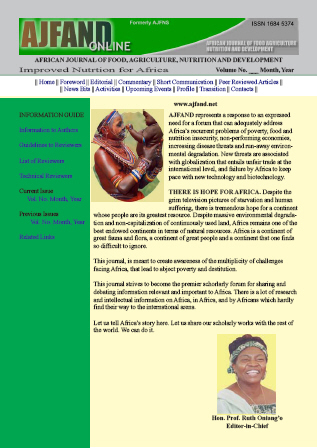
|
African Journal of Food, Agriculture, Nutrition and Development
Rural Outreach Program
ISSN: 1684-5358
EISSN: 1684-5358
Vol. 21, No. 3, 2021, pp. 17711-17726
|
 Bioline Code: nd21034
Bioline Code: nd21034
Full paper language: English
Document type: Research Article
Document available free of charge
|
|
|
African Journal of Food, Agriculture, Nutrition and Development, Vol. 21, No. 3, 2021, pp. 17711-17726
| en |
FOOD CONSUMPTION AND LIFESTYLE HABITS AMONG UNIVERSITY STUDENTS IN SAUDI ARABIA
Sami, R; Bushnaq, T; Benajiba, N & Helal, M
Abstract
Food consumption and lifestyle habits can have a positive or negative direct impact on
an individual’s health. University students tend to have poor eating habits that are
influenced mainly by sensory perceptions. This survey was done to evaluate the status
of food consumption and lifestyle habits among Taif university students (males and
females). A total of 600 students aged from 18 to 24 years participated in the survey
and responded to questions on socio-demographic characteristics, lifestyle habits,
eating habits, food consumption frequency, attitude, health and food awareness
knowledge. The randomly selected students were from various levels in university
representing wide categories and living conditions in Taif Region, Saudi Arabia. The
examined students efficiently completed the survey with the help of the university staff.
Weight and height were evaluated by a portable standing electronic scale and a portable
stadiometer (Seca 879, Germany) to calculate the Body mass index (BMI) classes.
Female students recorded 28% of underweight cases, which was higher than the male
students (11%) with none significant at p>0.05. The rate of overweight in male students
was 30% compared with the female students’ 26%. The study reported 49% and 64%
for normal waist circumference for male and female students, respectively. A higher
frequency of moderate physical exercise was reported among male students at 60%
compared to that among female students (57%). The number of students who did
physical exercise regularly was reported to be higher in females (15%) than males
(8%). A percentage of 15% and 7% of the male and female students, respectively were
smokers. Male students recorded higher sleeping hours than females. Male students
reported high media consumption frequency of more than 3 hours a day 67%, followed
by 21% between 3-6 hours a day for female students. About 46% and 55% of male and
female students, respectively, reported fast-food consumption at least once a week and
about 30% of males and 24% females took only 1 to 2 fast food meals in a month. The
major meals skipped were breakfast, followed by lunch and dinner; however, this was
not significant p>0.05. Meal skipping was high among female students (72%). It was
noted that high percentage of male students (72%) reported low consumption levels of
vegetables and fruits. The main reason for fast-food consumption was convenience
(31%) for males, while females recorded 32% for choices. Female students had a
higher score than males in nutrition knowledge. There is a need for awareness creation
concerning better food choices, lifestyle habits and weight management that might
create a helpful impact on the university student health.
Keywords
fast-food consumption; food choices; nutrition knowledge; university populations; survey
|
| |
© Copyright [2021] - African Journal of Food, Agriculture, Nutrition and Development
Alternative site location: http://www.ajfand.net/
|
|
